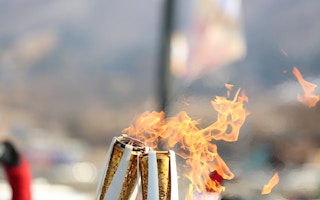The Olympics offers us a time of hope, a time for mutual understanding, a time for goodwill and peace. But as all eyes turn toward Pyeongchang for the 23rd Winter Olympic Games, rising temperatures, melting glaciers and rising seas threaten to dash many of these lofty hopes and dreams.
Just as world leaders got together in 1992 to re-affirm an Olympic Truce through the United Nations, these Olympic Games offer us the real opportunity to affirm the real risks of climate change and the real steps we will need to take – as individuals, as communities and as nations – to protect our people and planet.
While tensions on the Korean peninsula will likely dominate the news around the games, we shouldn’t overlook the effects climate change will have on billions of people worldwide and how these changes will impact the very future of winter sports.
But the untold story of climate change and Olympic dreams is really about the farmers, fishermen and vulnerable communities living in the developing world whose lives and livelihoods are being put at risk by melting glaciers, bigger, faster avalanches, changing snowfall patterns, and other ecological factors connected directly with our mountains and watersheds.
In Bhutan for instance, glaciers are retreating somewhere between 30 to 60 metres per decade. This retreat is creating massive glacial lakes that can overflow and wipe out entire villages.
In Afghanistan 80 percent of economic losses are caused by climate-induced disasters. Changes in rainfall, glacial lake outflows and increased flash floods are taking lives, displacing people, and upending efforts to build security and peace.
And don’t forget that water runs downhill. Whether it’s from the world’s mountains and glaciers or the great polar ice caps, melting ice means rising seas and greater risks for every nation on our planet.
All these impacts will put people at risk, spawn increased migration, and destabilise economies and societies. That’s not a good thing for our Olympic dreams, it’s not a good thing for our dreams of ending poverty and hunger by 2030, and it’s not good for our goals of limiting temperature rise by two degrees.
“
While tensions on the Korean peninsula will likely dominate the news around the games, we shouldn’t overlook the effects climate change will have on billions of people worldwide and how these changes will impact the very future of winter sports.
So what can we do? This Winter Olympics offers us a unique vantage to understand not only the risks behind climate change, but also the solutions.
Think of it this way. While the Nigerian women’s bobsled team and the joint North and South Korea hockey team may not have access to the latest sports equipment and technology, they are still able to come together with the rest of the world to compete on an international stage and inspire girls the world over.
It’s about building strong institutions and even stronger people. With the right capacity, tools, technology and financial support, these nations have the potential to increase their resilience to climate risks and achieve the goals outlined through the Paris Agreement and 2030 Agenda. But they won’t get there alone.
The United Nations Development System, international financial institutions like the Green Climate Fund (GCF) and governments from around the world will need to come together to foster these local capacities.
This work is already underway. In Bhutan, where floods from glacial lakes could cause unprecedented human and economic damage to the villages in the verdant valleys below, a project financed through the Global Environment Facility Least Developed Countries Fund has successfully lowered the level of glacial lakes.
In Pakistan, a GCF-financed project will scale up measures to reduce the risk of flooding from glacial lake outbursts. In Tuvalu, a GCF-financed Coastal Adaptation Project will provide key protections from sea-level rise.
It’s a good start. But it’s not enough. Adaptation costs alone in developing countries may rise to $150 billion or more by 2025.
We need to come together, just like we do for the Olympics, as a world. This is the chance for every nation on earth to re-affirm our commitment to low-carbon climate-resilient development. In the end, we are richer as a people, and as a planet, when we come together.
Pradeep Kurukulasuriya heads the Climate Change Adaptation team in the Global Environmental Finance Unit at UNDP. This article is republished from the Thomson Reuters Foundation.











